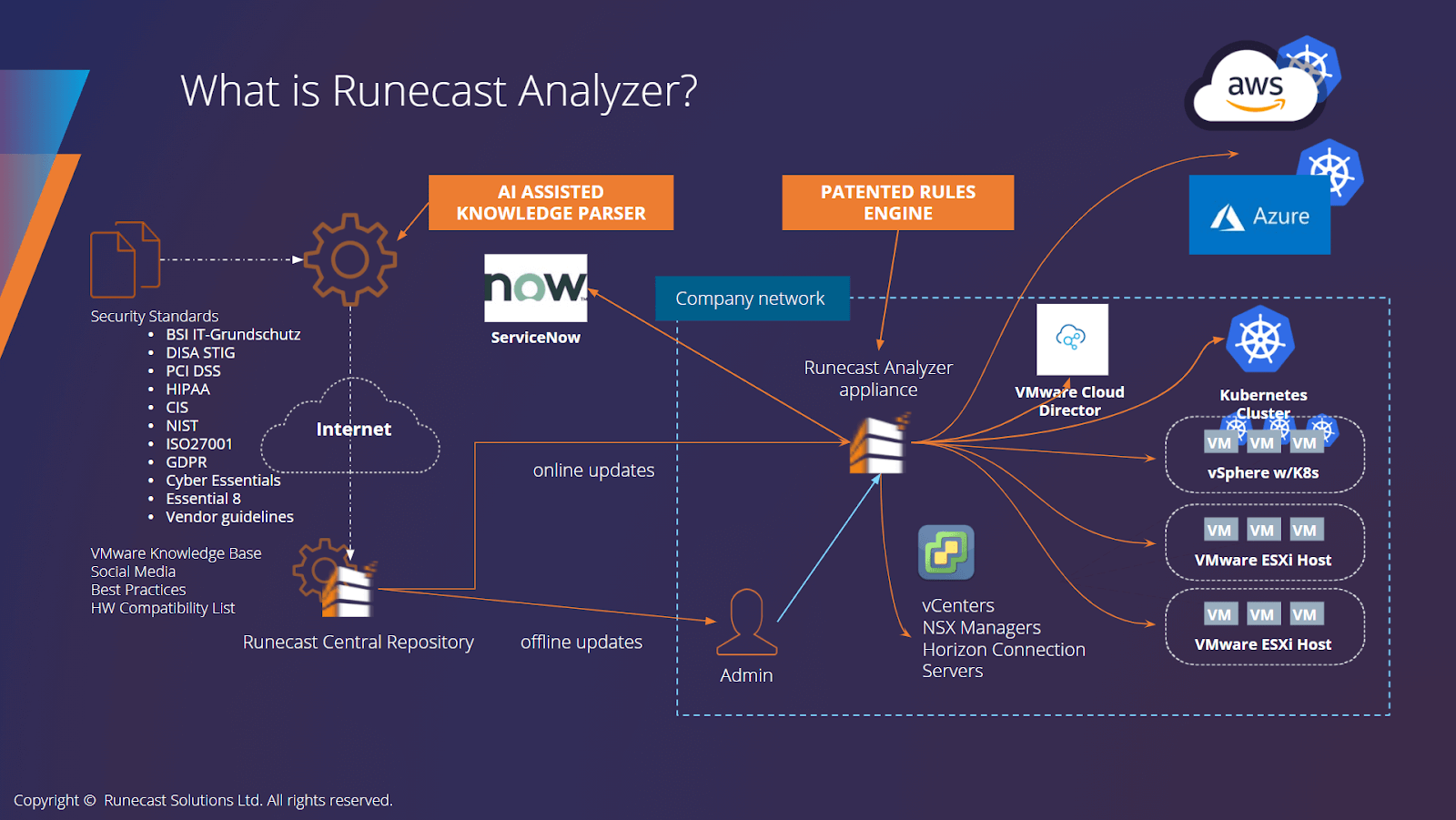How to properly categorize Runecast Analyzer
It can be difficult to describe a new technology that changes ways of seeing and doing things, evident in historical phrases such as ‘horseless carriage’ (“What, you mean I don’t need a buggywhip to drive it? Where are the reins?!”). Suddenly it wasn’t just that the horse was gone, but the carriage was actually ‘automated’ and required an entirely new approach to ‘maintenance’ (although we still measure with ‘horsepower’).
Both Capterra and Sourceforge classify Runecast Analyzer under Data Center Management Software, while G2 categorizes it as Cloud Security Software and Cloud Compliance Software. (Notice the distinction between ‘Data Center’ and ‘Cloud’ that will eventually be as redundant as the ‘digital’ and ‘global’ in many job titles from the 1990s and early 2000s.)
Runecast Analyzer began as a VMware-specific analytics tool. Naturally, as more organizations find themselves migrating to cloud services such as Amazon Web Services (AWS) or Microsoft Azure, or utilizing Kubernetes containers, these processes have developed as well into cloud security posture management (CSPM). By 2020, Runecast was named a Cool Vendor in Gartner's Cool Vendors in Performance Analysis for Cloud-Native Architectures report, and later that year Runecast Analyzer won Computing's SME award for Cloud Security Product of the Year. Clearly, IT management was becoming cloudy (pun intended).
Of course, within each of these categories are additional subcategories, depending on specific actions to be performed. Some might thus file Runecast Analyzer under 'configuration management tools', 'vulnerability management tools', ‘application performance monitoring (APM) tools’, ‘security compliance tools’, or similar phrases and their acronyms relating to system engineering processes that seem to transform almost daily (ever toward the level of automation that Runecast Analyzer provides and continues to evolve).
At its core, Runecast Analyzer uses Artificial Intelligence for IT Operations, or as Gartner refers to it, AIOps (an acronym for 'Algorithmic IT Operations'). And the technology inside – Runecast AI Knowledge Automation (RAIKA) combined with a patented, deterministic rules engine – analyzes millions of data points to proactively cover a vast array of common IT challenges, such as performance analysis, vulnerability assessment, and security compliance audits.
Regardless where it fits in specifically or overlaps extensively, Runecast Analyzer will continue to evolve along with IT operations management (ITOM) in the years to come. That it has done so since its inception – with proactive, predictive intelligence – makes the case for...
Being classified as a ‘must-have’
Perhaps our favorite Runecast Analyzer classification to date is the term ‘must-have’.
We’ve heard it from System Engineers like Stephen Parker of BYU Idaho, an American university (“Thanks to Runecast Analyzer I am saving 2-3 hours a day. I would highly recommend this solution as a 'must have' for any VMware vSphere environment”) and longtime virtualization industry expert Jane Rimmer (“it is clear that Runecast Analyzer is a ‘must have’ in any VMware vSphere environment”), among others.
Part of that sentiment stems from numerous factors, such as Near East Bank saving 90% of time previously spent troubleshooting or FLEXdata anticipating 90% time savings when upgrade planning. Or let’s talk about uptime (the ultimate goal, right?), of which ONI credits Runecast Analyzer for its 100% uptime service delivery (see video).
The capabilities in Runecast Analyzer grow with IT Admins’ needs (Customer-centric is one of our core values). Since version 5.1 launched on 8 July 2021, Runecast Analyzer shows a clear picture of configuration drift by pulling from its historic data to compare changes made between selected points in time. The configuration drift data is also included in email reports, so you can be notified of any changes in your environment and keep full control. In terms of remediation capabilities, the analyzer now provides system administrators with an auto-generated script for making specific remediation actions – to make vulnerability scanning, patch management, security compliance and uptime far simpler for SysAdmins, reducing the time spent on reactive operational tasks and manual steps.
Where did the Runecast name come from?
One question we get asked from time to time is how the name Runecast came about. Runes were ancient symbols used a lot like an alphabet (prior to the adoption of the Latin or Cyrillic scripts in much of Europe). Runestones – small stones with runes carved into or painted on them – could be arranged by those who cast runes (i.e. runecasters) in various ways, enabling the runecaster to obtain guidance in making difficult decisions or even see the future (runecasting history, origins, and how it worked). Basically, runecasting was their version of data analysis.
Runecast Analyzer therefore acknowledges our human history and aims to provide the same (OK, actually much better) level of guidance and visions of the future as we evolve into new technological eras.
Now that we have all that sorted, we just need to keep helping SysAdmins relax. We get it, you're in a hurry, as we get called all of these things via your fast typing:
- runcast
- runcats
- runecats
- rune cast
- rune tool
- rune software
- ruencast analyser
- runecast analzyer
Regardless of what you might accidentally call it, you can check out our online demo or contact us with any questions you may have.
Meet other Runecasters here:
Try Runecast Analyzer
For testing (proof-of-concept or demonstration installation), a free version is offered that performs a complete analysis but shows limited results.


